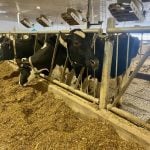Canada’s farmers are “well-positioned” to take advantage of emerging tastes and trends in the global market, though success will depend at least partly on effective public policy, according to a report Wednesday by the economics wing of TD Bank Financial Group.
The report by Derek Burleton of TD Economics admits that the half-decade since 2002 “has to rank as one of the most challenging periods on record,” citing the rising loonie, fuel costs, poor cropping conditions and animal health crises such as BSE and avian flu.
However, he wrote, “the pendulum has recently swung to the sector’s unprecedented opportunities — and not just for farmers but the entire agricultural value chain.”
Read Also

Exploring Harvest Safety
Kristin Hoffman of WSPS explains measures for increased farm safety around harvest season
The report cited bids to develop new energy sources while also meeting emerging market demand for food, which combined have led forecasters to crank up their medium-term ag price forecasts.
TD Economics still expects crop prices to fall back to some extent in 2008, for reasons such as the price strength now coming from “temporary factors” such as droughts in other countries — as well as “short-term speculative flows” and the likelihood of “significantly higher” acres seeded to wheat next year.
In the livestock sector, meanwhile, cattle producers have been able to shore up prices somewhat by cutting herd sizes, while hog markets still offer “little reprieve.” However, the department suggests “the current ultra-low level of hog prices is not sustainable, although the projected recovery is expected to be a gradual one.”
Beyond 2008, however, the price picture is “bright” as emerging markets such as China and India keep overall global consumption running briskly.
TD cited world agricultural outlooks showing rates of growth in consumption increasing by 0.5 to one per cent per year for wheat and rice and up to three per cent per year for meat and poultry between now and 2016. Developing countries’ production will also rise in lockstep, but not as quickly as their consumption of wheat and some other commodities.
“Second, we don’t expect any monumental slowdown in efforts to derive energy from agricultural products,” Burleton noted.
Costs
However, improved profit margins will be limited by factors such as costs of production, he wrote, citing “no significant relief” on interest rates; historically high energy and fertilizer prices; “fierce” competition for labour; ocean freight rates expected to rise at five per cent per year through 2010; and a continuing strong loonie.
Faced with costs still outstripping revenues, Canada’s ag and agri-food sectors have put new technologies, processes and techniques in play to ramp up productivity, Burleton observed.
Among those, he cited tracking systems for cattle and bison; GPS and field-imaging technologies; increased use of the internet to help pencil out costs and revenues; technologies to cut energy use and protect soil and groundwater; and progress in grain inventory management, cutting the time grain spends in the system to 56.6 days (2006) from 67.4 days (2002).
In terms of government policy, TD noted the next six to 12 months will be a “critical period” for farmers as ag ministers hammer out the “Growing Forward” policy to replace the expiring Agricultural Policy Framework (APF).
However, Burleton also noted surveys that show farmers to be just as interested in cutting red tape, fees and paperwork as well as their total tax burden. Farmers also need to see progress made on reducing other nations’ farm subsidies, whether it be through the World Trade Organization or bilateral agreements.
The “broad elements” of Growing Forward so far line up well with the ag industry’s concerns, TD noted, “but the devil will be in the details.” A new policy framework could be a major opportunity to boost the sector’s longer-term prospects and “we are optimistic that it will not be squandered.”
GDP
While primary agriculture’s share of Canada’s gross domestic product has dropped from 25 per cent in 1900 to between one and 1.5 per cent recently, the report noted that it “remains at the core of a much larger agri-food system.”
Including input and service suppliers and secondary food processing increases ag’s share of GDP to 4-4.5 per cent, and including foodservice and food retail and wholesale business that figure rises to eight per cent.
Canada remains the world’s fifth-largest ag and agri-food exporter after the European Union, U.S., Brazil and Australia, making a “disproportionately high” contribution of 10 per cent of Canada’s trade surplus, TD noted.














